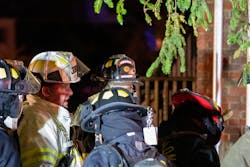It often is stated that a person’s true leadership ability is related directly to his/her ability to influence others. A leader is only as effective as the people who follow will allow.
Nobody can be successful in life doing things alone. So very much of what we accomplish only can happen through the efforts of many. True leadership involves getting extraordinary results from the combined efforts of ordinary people. Good leaders utilize the talents of those who are around them, seek advice from those who have more experience and treat others with respect. It’s rather simple, but it’s a powerful premise.
Management vs. leadership
Often, the word management is used when discussing the role of a fire officer. However, caution must be used, because management and leadership are very different animals and shouldn’t be confused for each other. Management is the process of controlling people or running systems to get results. Leadership involves using skills to produce positive changes. For the fire officer, it’s absolutely necessary that a mixture of both of these are utilized correctly. Fireground decision-making doesn’t allow for discussion when time is critical and lives are at stake. As well, day-to-day things that affect members inside of the firehouse definitely allow opportunity for leadership principles to be employed.
Leadership begins with making certain that a sense of safety and trust exists among your people. Our job deals with life and death on a regular basis as well as other forces that try to keep us from success. We have no control over these external forces but do have control over the internal environment of our organization.
Why are we willing to put ourself in danger when one of our own is in trouble on the fireground? Simply put, because they would do the same for us. This comes from a deep sense of trust. This trust is unlike any that’s experienced in any other line of work outside of the military or emergency services. As human beings, we are no better than others, but the environment that we work within is different. The corporate world is willing to put profit margins ahead of people; our profession always puts people first. It’s why we exist. The terms colleagues and co-workers are utilized when talking about the environment in the corporate scene; in the fire service, we use the terms brothers and sisters. Inside of the fire station, we will tease, joke and fight with each other, but if there is some force from the outside that threatens the safety of one of our own, we will go to the ends of the Earth to help them—no different than a real family. This becomes possible through common beliefs, values—and good leadership.
Trust
Leadership comes down to creating an environment of trust within an organization. There isn’t one thing in particular that can be told to aspiring leaders to get others to trust them. There are no shortcuts. Patience, time and experience are necessary, because trust is an accumulation of doing the right things consistently, time and time again. You must believe in your message and be consistent. Results often aren’t immediate, but they will be realized in terms of loyalty over the long haul.
Think about when trust for a leader doesn’t exist. People in the organization won’t deviate from the rules of the organization out of fear, which can severely handcuff the organization from moving forward as well as lead to missing valuable opportunities. People will learn to work around leaders who are untrustworthy and don’t keep their word.
People must have the power to act, so they have a sense of pride or ownership in a group. A leader who delegates effectively gives people a sense that they can have some control of their work environment. Constantly checking and correcting the work of others will come across as micromanaging and will convey to people that they aren’t trusted by the leader. When this trust doesn’t exist, people will lack the confidence that’s necessary to take risks in relation to bringing new ideas forward.
Leaders look out for the people who work with them, develop their people and make sure that their people have the resources to safely do their job. They also provide a clear vision, which begins with setting expectations.Clear and simple
What leaders expect from and how they treat their workers determines how their people will perform. Expectations are the boundaries for people to work within and are part of a motivational environment. Expectations need to have purpose, be reasonable and be in line with the mission of the department. If a leader communicates high expectations and demonstrates confidence that the workers are able to fulfill those expectations, the workers generally will.
People also need to know how they are to meet those expectations. Communication will need to be very clear and simple in regard to priorities and objectives, so people understand expectations. Definitive plans will produce definitive results. Without fully understanding, people will formulate their own objectives or follow someone else who seems to have a vision or purpose. This might or might not be in the interests of the organization.
Communication is the single most important factor that can make a difference in the behavior and morale of an organization’s members. So, in today’s world, why do problems with communication exist, when the mediums to communicate are so numerous? Email, voicemail, text messages, cellphones and social media outlets permit information to be sent between individuals, but this isn’t good enough. Often, the problem isn’t the quantity of communications, but the quality. Quality communication must be a two-way process that includes both sending a message as well as receiving it. Today’s communication media that are commonly used have depersonalized this process.
The context of what things are supposed to mean and why decisions are put into place needs to be made clear to people. Without this, people are apt to give their own meaning to issues. When communication isn’t open, the “grapevine” and “rumor mill” will become prevalent, which causes problems that will be very difficult to repair later.
Having information is considered to be a source of power, but true power comes from the dissemination of information and the empowerment of members of the organization. Some of the greatest advice for leaders is to make themselves visible and available to the people who they lead.
Confrontation
The more successful that you are in moving up the ladder in your career, the more likely that you eventually will move into a position in which you will be taken away from your comfort zone, from doing things that you like or are good at. One of the most uncomfortable things about moving up as a leader is dealing with confrontation.
Human nature is to want everyone to like you, but that isn’t always possible when tough decisions within an organization must be made. Confrontation is necessary and must be met head on. Avoiding it destroys a leader’s credibility more quickly than anything else. Remember, our job is a dangerous profession that requires serious people. Being a good friend can lead to someone getting killed; being a good leader can mean your members return home safely after their shift.
When something goes wrong, confront the problem, not the people. Discuss “what” went wrong rather than “who” when discussing issues. Leaders need to tell it like it is, always using the absolute truth and known facts. Using “fluff” in expressing priorities and goals should be avoided at all cost. Truth that isn’t necessarily nice is better than having to explain lies that could be detrimental to a project later.
It is very easy for a leader to become emotional when confronting issues. Showing some emotion is good. It expresses the passion that a leader possesses. However, emotion must be balanced to have an effect. Too much isn’t a good thing.
A leader must avoid taking things personally, so get to know and understand the “triggers” that cause you to become frustrated. Of course, this can be easier said than done. Leaders have no control over how someone thinks about them.
Losing your cool as a leader demonstrates instability, which diminishes credibility. People won’t want to bring things to a leader or to help a leader, because they will fear that their leader will lose it. Set the example by showing the performance, attitude and commitment that you expect from the group. Human nature is to imitate actions that are performed by others.
As a leader, if you “talk the talk,” you better “walk the walk.” If you find that you can’t do something as said, follow it up and explain why. Also, the fastest way to lose credibility as a leader is to fail in obtaining and maintaining the knowledge and skills that are required of your job and of the people who work alongside of you. This doesn’t mean that the leader can perform the skills better than the others, but the leader can understand them to look after the safety of their people and develop them.
Are you ready?
Leadership isn’t easy, particularly inside of today’s fire service. Everyone has the opportunity to lead at any level. Just because someone has a rank or title or because he/she is the biggest, strongest or fastest member of a group doesn’t mean that the person is the best leader for a group.
With hard work, believing in yourself, having courage and taking ownership, the best leadership skills can surface in all of us.
The Power Trip
Leadership sometimes is coveted by people for the wrong reasons. Some people thrive on enhanced personal identity and power. They need to make it clear to everyone that they are in control and have a greater value. If people feel that they are being used only to accomplish an agenda that they perceive to be selfish in nature, they won’t follow.
Leadership ability also doesn’t mean that an individual who possesses it is a good person. Consider Adolf Hitler, Saddam Hussein and Osama bin Laden: They had great influence over others, but their intentions were evil.
Constructive Criticism
Feedback is a necessary part of the communication process. It enables people to evaluate their progress and to make changes that are necessary to reach goals. It needs to be honest, objective and timely. Recognition must be given when possible. People need to know that they are important.
Proper feedback can help members to avoid working countless hours on something incorrectly or not aligning with the objective of the organization. It never can be assumed that expectations are obvious or understood. Ongoing feedback mechanisms help to improve employee performance and lead to less surprise when performance evaluations take place.
Listening is a major part of communicating and is one of the greatest attributes of successful leaders. It allows them to understand the needs of the people who report to them. This also allows members to feel that they have some control over their environment. Leaders need to listen to understand, rather than listen to reply. It is a true skill to keep opinions to yourself until others speak. Allowing others to have a chance to be heard ensures that the best solutions to problems that an organization faces are brought forward and considered.
A Born Leader?
Some people are born with a natural self-confidence in their abilities, while some need to work at it. The good news is that leadership skills can be developed. A person can’t control the amount of natural talent that he/she was given, but a person can control how much effort that is expended to develop his/her talents.
Leadership can be equated to a “dance”— if not prepared, one will stumble and fall. However, it’s the manner by which a person gets back up that will determine his/her future.
Leadership also can be compared to parenting. Parents make certain to provide opportunities, an education and discipline when necessary to their children to allow them to achieve great things. Leaders are much the same, except that they provide these items to build their team and to promote self-confidence in their members.
About the Author

Jeffrey Pindelski
JEFFREY PINDELSKI is the Downers Grove, IL, Fire Department Chief (Ret.) and has been a student of the fire service for more than 30 years. He served as a chief officer for more than 15 years of his career, during which time he directly managed every aspect of the fire department at one time or another. Pindelski holds a master's degree in Public Safety Administration from Lewis University and earned a Graduate Certificate in Managerial Leadership and a bachelor's degree from Western Illinois University. He is the co-author of "R.I.C.O.- Rapid Intervention Company Operations" and was a revising author of the third edition of "Firefighter's Handbook." Pindelski presented at numerous fire service conferences and had more than 55 articles published in trade journals on various fire service-related topics. He is a recipient of Illinois' Firefighting Medal of Valor.

